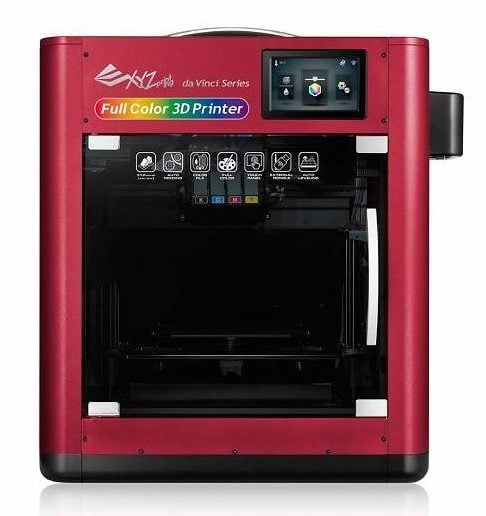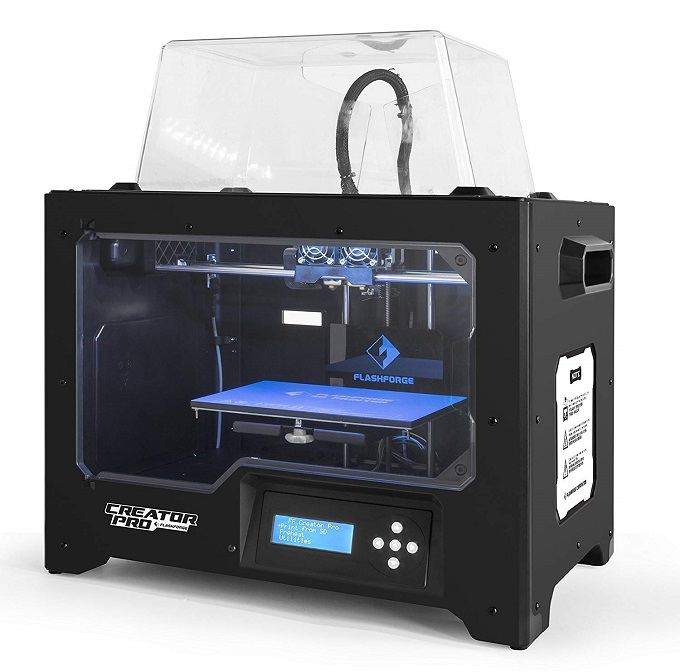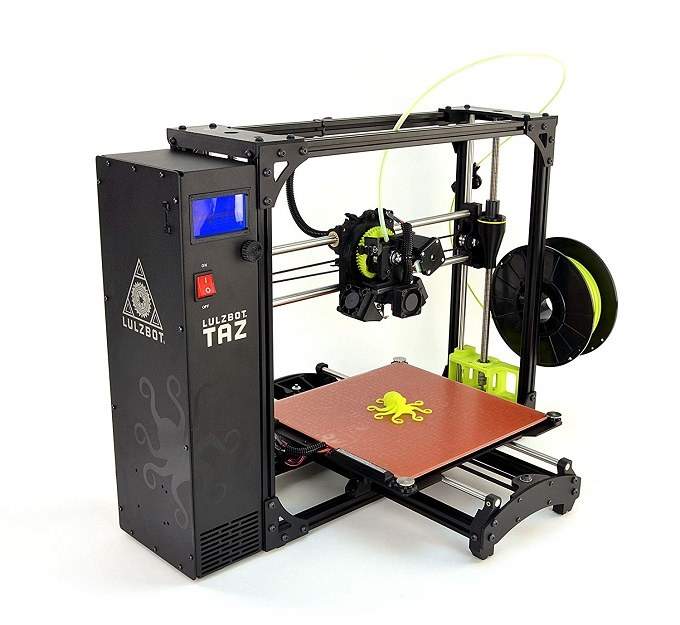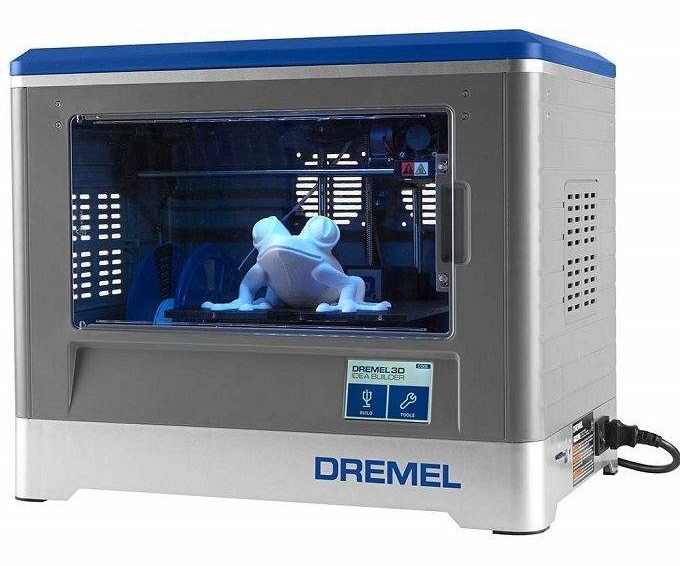Prices have also been plummeting, which means that tinkerer’s on a budget can get some decent, affordable 3D printers. That’s not what we’re looking at here however. The printers listed here are ones that have pushed the industry forward as far as consumer printers are concerned.
Their features, capabilities and quality represent a quantum leap over the virtually homemade machines of the early days. So feast your eyes on four of the best 3D printers you can buy in 2019.
da Vinci Color
XYZprinting has really made a name for itself over the last few years. Their printers are consistently innovative and there are many good choices in the product range. For example, their da Vinci AIO products also include a 3D laser scanner, which turns the printer into a 3D photocopier of sorts. While FDM printers have become quite mature, most are still limited to printing in a single color. Dual- or multi-extruder models can be used to easily print in multiple colors. One for each extrusion head. However, if you want a proper full-color 3D object there haven’t been any consumer products up to the task. Enter the da Vinci Color. This printer feels like a real step up for the technology. It combines FDM 3D printing with CMY ink printing technology. The end result is a system that can color the outer layer of your print however you like. So you no longer need to hand-paint your prints! The da Vinci Color feels like the beginnings of the sci-fi replicators we imagined 3D printers could be. It’s not a one-trick pony either. There are many high-tech features under the hood. WiFi is a given on high-end models these days, but it also has a neat magnetic print bed and sports a sophisticated auto-calibration system. The 7.9 x 7.9 x 5.9 inch print volume may be a little tight for some, but the vast majority of users will be perfectly happy with that much room. The only real gripe is that the 100 micron maximum resolution is quite a bit grainier than the 20 micron resolution on the da Vinci Pro. If the price of the Color is too rich for your blood, there’s a Mini version of the printer now available for pre-order.
Flashforge Creator Pro
Flashforge already had a good thing going with the original Creator model. This new Creator Pro model takes what was great about the original and dials up the quality. Better (and more expensive) materials were chosen for the Pro, making it sturdier and more attractive. You get aviation aluminum guaranteed not to warp under heat and a metal frame, in place of wood. The new metal construction and guide-rod assembly are all aimed at precision and reliability. To top it all off, the built chamber is insulated, so that ABS (it also supports PLA) cools consistently. This is also a dual-extruder printer, which opens up all sorts of possibilities. Yes, you can use filaments of different colors for two-color prints, but of much more interest is the ability to have different grades of material for supports and final product. This is a no-frills printer that knocks out high-quality prints a clear step above most other machines in this price bracket. Speaking of which, the Creator Pro initially launched with a price well north of a grand and has seen consistent price cuts, now going for almost half of the original tag. It was already a strong competitor at full price, but at the time of writing you’d be hard-pressed to find something this good for so little.
LulzBot Taz 6
Despite the goofy name, the LulzBot Taz 6 is anything but a joke. This is an advanced, open-source, open-air 3D printer. It sports a massive build volume of 11.02” x 11.02” x 9.8” and a price that’s equally voluminous. It’s not overpriced by any measure however. This is a SERIOUS printer that’s reliable enough to run constantly in a factory setting. Indeed, Lulzbot actually does this, with 150 machines printing parts that go into the printers that customers ultimately buy. While there’s no WiFi connectivity, you don’t need to hook the Taz 6 up to a computer. It supports SD card printing, which means you only have to walk over with the model files to get going. Maintenance is also kept to a minimum, with self-leveling and self-cleaning features, making this a very convenient machine to own. Of all the things that impress about the Taz 6, the print head is at the top of the list. The printer has been designed to be modular, which means you can upgrade or modify your existing printer to support dual material printing and a long list of printing materials, including wood and metal composites, nylon filaments and printing materials that haven’t been invented yet. That’s some serious future proofing and makes the fat price tag much more sensible in this context.
Dremel Digilab 3D20
Dremel is one of the top power tool makers in the world, so it makes a lot of sense for them to try their hand at making a desktop 3D printer. The Dremel Digilab certainly looks the part, with a pleasing metallic finish and enclosed build space. There is absolutely no pre-assembly, making this one of the most consumer-friendly 3D printers on the market. Since this printer does not have a heated build platform, you are limited to PLA material. That may not be a bad thing, since Dremel is pitching the Digilab as a high-quality desktop printer. PLA tends to be used for models that need better details and overall finish, not ones that will actually be used for practical parts. This focus on PLA means the Digilab is tuned to that material, making it much more likely that your prints will come out the way they are supposed to. Dremel claims that the 3D20 is the most reliable 3D printer on the market, backing it up with their testing regime. Of course, we have no way of verifying reliability claims, but Dremel has a reputation for making reliable tools. This is why the brand is such a favorite among builders and makers of all stripes. Other quality of life features include a full-color touch screen and the ability to print from an SD card. That means the Digilab can operate independently from a computer, with a very friendly UI. The only potential drawback is the 9”x5.9”x5.5” build volume. If you want to print models that are larger than this, you’ll have to look elsewhere. Otherwise, this is probably the best “sweet spot” desktop printer you can buy today.
The Time is Now
Standard material deposition 3D printers are now ready for primetime. There’s no reason to hesitate on pulling the trigger when it comes to desktop 3D printers any more. While there is still a lot of innovation on the horizon, the next generation of 3D printing technology isn’t going to make it to your desk any time soon. This means that waiting doesn’t make a lot of sense. If you buy a modern 3D printer now, it should stay relevant for years to come, until they find a way to bring true multi-material printing to the home market. If you’ve always wanted a 3D printer, 2019 is as good a time as any to finally buy one. Enjoy!



